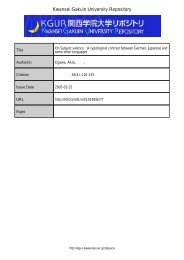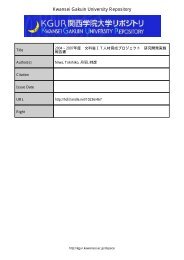Kwansei Gakuin University Repository
Kwansei Gakuin University Repository
Kwansei Gakuin University Repository
You also want an ePaper? Increase the reach of your titles
YUMPU automatically turns print PDFs into web optimized ePapers that Google loves.
It has often been argued that Japanese domestic industry is characterized by<br />
low metabolism and inefficient reallocations between incumbents and entrants. Some<br />
studies have argued that the natural selection mechanism does not work well in pe-<br />
riods of recession (e.g., Nishimura et al., 2005; Fukao and Kwon, 2006). However,<br />
these studies focused mainly on the behavior of established firms; hence, different<br />
results might be obtained if the behavior of new firms was highlighted. Despite the<br />
importance of entry and exit for the natural selection mechanism through compe-<br />
tition, little attention has been paid to the post-entry performance of new firms in<br />
Japan.<br />
The findings of this paper include several important implications. The results<br />
show that bankruptcy is less likely to occur in industries with high capital and R&D<br />
intensities, whereas voluntary liquidation and merger are more likely to occur in<br />
capital-intensive industries. This fact may suggest that factors of production tend<br />
to be reallocated without bankruptcy in the industries where sunk costs seem higher<br />
because of asset specificity among the manufacturing industries. In addition, the<br />
results indicate that the variables on the intensity of market competition, such as<br />
price–cost margin and gross entry rate, generally increase the probability of exit of<br />
new firms, after controlling for region-, firm- and entrepreneur-specific character-<br />
istics. Alternatively, the results imply that while entrepreneurs with high human<br />
capital are less likely to go bankrupt, they have more opportunities to change their<br />
jobs voluntarily or to be successfully acquired by other firms. These findings may<br />
indicate that efficient reallocation through the natural selection mechanism works to<br />
some extent in Japanese manufacturing industries. We suggest that policy makers<br />
should pay more attention to industry dynamics and apply the natural selection<br />
mechanism to the development of industries. Therefore, we argue that this pa-<br />
per provides a better understanding of industry dynamics and important ideas for<br />
economic policy.<br />
25
















